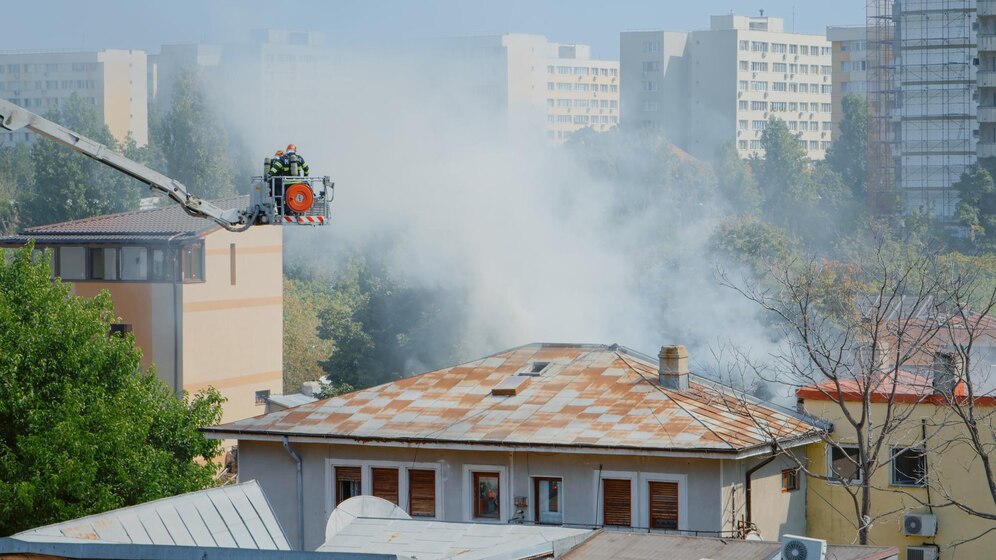Fire safety is a crucial consideration when choosing roofing materials for your home. Roofs are constantly exposed to the elements and risks, and selecting fire-resistant materials can make a significant difference in protecting your property. Whether from wildfires or accidental blazes, having a roof that can handle high temperatures is a smart choice for any homeowner.
Interest in fire-resistant roofs is growing as more people recognize the benefits of increased home protection. Knowing the different fire ratings and material types helps homeowners make informed choices. Roofs rated for high fire resistance provide peace of mind, especially in areas prone to wildfires.
Understanding the essentials of roof fire safety, such as selecting appropriate materials and regular maintenance, can significantly improve your home’s defenses. By focusing on both material selection and upkeep, homeowners can take proactive steps to safeguard their families and belongings from the threat of fire.
Understanding Fire Ratings for Roofing Materials
Fire ratings are an important factor when selecting roofing materials. These ratings indicate how well a material can withstand fire and are classified into three main categories: Class A, B, and C.
- Class A offers the highest level of fire resistance. Roofs with Class A materials can withstand severe fire exposure and provide the best protection. These materials are ideal for homes in areas with a high risk of wildfires.
- Class B materials provide moderate fire protection and can resist moderate exposure. They are suitable for areas with a lower risk but still require some level of fire resistance.
- Class C is the minimum level of fire protection. These materials can only handle light exposure to fire.
Selecting the right fire-resistant material is crucial for protecting your home. Materials with higher ratings provide better safety and peace of mind. When planning a roof installation or replacement, choosing the highest-rated materials that fit your budget and needs ensures optimal fire defense.
Common Fire-Resistant Roofing Materials
There are several common roofing materials known for their fire-resistant properties, each offering different advantages in terms of both protection and aesthetics.
- Asphalt Shingles: Asphalt shingles are a popular option because they offer Class A fire resistance, especially when treated with fire retardants. They are affordable and come in various colors and styles.
- Metal Roofing: Metal roofs provide excellent fire resistance and are naturally non-combustible. They are lightweight, durable, and ideal for homes looking to maximize fire safety.
- Tile Roofing: Made from clay or concrete, tile roofs are also non-combustible and provide good fire resistance. These materials are heavier than other options but offer a classic, elegant appearance.
- Slate Roofing: Slate is another non-combustible material that performs well against fire. It is highly durable and offers a unique, natural look, though it can be more costly.
Each of these materials presents a reliable barrier against fire while complementing various architectural styles. Selecting the right material often depends on your preferences, budget, and location’s fire risk.
Installing and Maintaining Fire-Resistant Roofs
Proper installation of fire-resistant roofing materials is vital for maximizing protection. Start by ensuring that an experienced professional handles the installation, as they are familiar with best practices and safety standards.
Key installation techniques include using the right underlayment, which serves as a crucial barrier to enhance fire resistance. Specialists also ensure that overlapping materials are tightly secured to prevent any small gaps that could allow embers to penetrate.
Once installed, regular maintenance is essential for maintaining the roof’s fire-resistant properties. Begin by scheduling routine inspections, especially in regions prone to wildfires. These inspections help identify and address any wear or damage promptly. It’s also important to keep the roof clean and free of debris, as dry leaves and twigs can pose fire hazards.
Additional maintenance tips include checking for any loose materials, such as shingles or tiles, and ensuring proper ventilation throughout the attic space. These steps ensure the roof performs optimally, providing your home with the best defense against fire threats.
By being proactive, homeowners can extend the life of their fire-resistant roofs and enhance overall safety.
Additional Fire Safety Tips for Homeowners
Beyond selecting the right materials, there are several other steps homeowners can take to bolster fire safety. One effective method is clearing debris from around the home regularly.
Twigs, leaves, and other plant materials are highly flammable and can ignite when exposed to embers. Trim any overhanging branches near the roofline, as these can serve as pathways for fire to reach the rooftop.
Installing fire-resistant barriers and vents is another way to improve your home’s safety. These components can help block embers from entering your attic, where they might otherwise ignite stored items. Additionally, sealing any gaps or openings in the roof or siding can prevent embers from sneaking into hidden areas.
Remember, keeping gutters clean and free from debris will also reduce fire risk. Precautionary measures such as these act as the first line of defense, slowing down potential fires and giving more time for emergency services to arrive. Taking these simple yet effective steps can greatly diminish the risk of fire impacting your home, offering peace of mind for you and your family.
Conclusion
Understanding fire safety and the role of roofing materials plays a significant part in protecting your home.
With various fire-resistant options available, from asphalt shingles to tile and slate, homeowners have the benefit of choices that suit both their style preferences and safety needs. Proper installation and regular maintenance ensure these materials provide the best defense against potential fire threats, safeguarding both property and lives.
If you’re considering upgrading your roof with fire-resistant materials or want to enhance your home’s fire safety measures, James Kate Roofing & Sola is here to help. Our expert team in the Dallas-Fort Worth Metroplex specializes in roofing and solar services, providing solutions that emphasize safety and reliability.
Contact our roofing contractors today to learn more about how we can protect your home from fire risks while enhancing its overall resilience.

